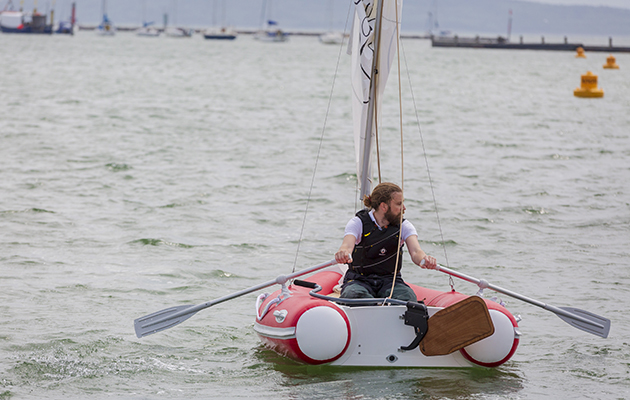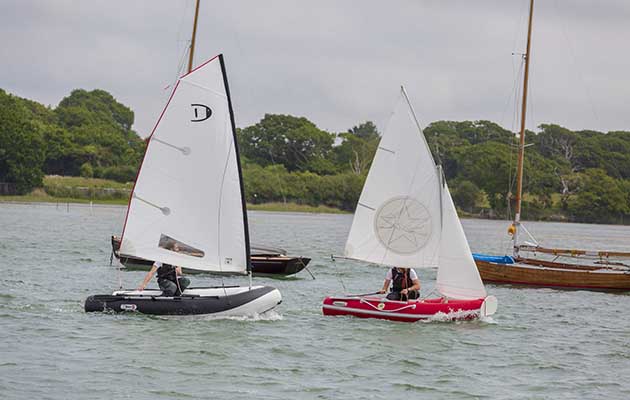Seal (prototype)

The mainsail can be easily scandalised, adding versatility
First and foremost, the Seal inflatable dinghy we tested was a prototype with some small modifications to come.
Specifically she does not yet have the two bags within which she will be supplied as standard.
We measured the longest parts of all the equipment to come up with the rough dimensions the bags would be in the final instance.
We’re reasonably certain that we have provided an accurate representation of the size the bags will be, but in this instance the measurements in the comparison table should be taken as a guideline.
The Seal is most directly comparable to the Dinghy Go models though with some differences.
She is one of two sailing singhies tested with a stayed rig and headsail with a sprit mainsail, reminiscent of an Optimist dinghy.
As with the other two-sailed option on test, the Seahopper, this extra sail adds complexity to the rigging process but does help balance when sailing her.
The headsail also means that the mainsail can be much smaller than on the single-sailed variations.
Seal specifications
Price: Pending
Length: 2.8m
Beam: 1.5m
Total weight: 57kg
Biggest bag dimensions: 110cm x 68cm x 40cm
Assembly time: 23 min
Website: i.thacker@ntlworld.com
Seal set-up
Set-up for the Seal was straightforward and took a comparable time to the two Dingy Go models – both of which are similar in hull design, though without the hard pram bow.
It is worth noting on the Seal dinghy that both the thwart and a small forward section slot into a groove along rubber runners down either side of each piece.
This is much easier to do when the tubes are not fully inflated.

The thwart is slotted in while the boat is partially inflated
With a bit of practice (and an electric pump) this could be done as the boat is inflating but if forgotten it would mean deflating the tubes slightly to install them and then re-inflating.
As previously mentioned the Seal comes with headsail and mainsail, which adds to the complexity of the setup.
In light of this we were surprised when we stopped the stopwatch to find it had taken only a few minutes longer than the single-sailed Dinghy Go varieties.
This is the a prototype of the dinghy and production versions will be available early next year.
Seal test
Sailing
Under sail, the Seal was well balanced, thanks to her two-sail setup.
The general view of the testers, however, was that the mainsail could be a little bigger and provide a touch more power.
That said, she was the second fastest under sail we tested.

The headsail helps with upwind performance
Although these measurements should be taken with a pinch of salt due to the variable and puffy conditions experienced during test day.
It was easier to handle both sails than it had been on the Seahopper, with well-placed cleats for the jib sheets.
Two adults would fit while sailing, but she has slightly less room than the Seahopper.
Primarily, you would expect her to be used for sailing.
Under motor
The Seal motored along quickly and was second only to the Seahopper in terms of outright speed.
The tiller has a nice detail in that when sailing it has a ‘u’ bend in it.
This allows you to lift the rudder, unlock the tiller and rotate 90°, providing enough space to mount an outboard to one side without having to take the rudder stock off.
Steering is then with the rudder rather than the engine.
The jib can be dropped easily.
The mainsail, thanks to its sprit rig, is easily scandalised with a single line.
These small details mean this is probably the quickest and simplest of all the options we tried to convert from sailing mode to rowing or power.
The Seal has a rather flat hull rather than the V-shaped hull of her competitors.
This small detail reduced her directional stability, though not too badly.
Rowing
The Seal rowed easily with oars that remain attached to the inbuilt rowlocks.
These are clipped onto the side tubing when not in use.
Again this makes converting from sailing mode to rowing mode a quick and simple task.

A topping lift lets you scandalise the main for short rows
As with all inflatable tenders she performed less well rowing into a stiff headwind; her scandalised mainsail made it particularly hard work.
Drop the main, however, and the rig if necessary, and the effort required drops significantly.
With the rig out she compared well with all the others on test.
YM Verdict
The Seal and the Seahopper were pretty even in terms of interchangeability between sailing, rowing and motoring modes.
Both felt as though you could go out sailing with a motor on the stern and choose whether to continue sailing, fire up the engine or row.
The Seal we tested was a prototype and would normally be stowed.
Once available, this will be an impressive all-round option.
Anyone who harks back to the Tinker Tramp dinghies will find this familiar.




